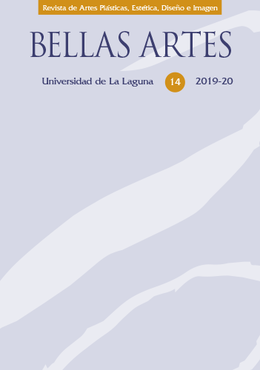El placer de la complejidad en el lenguaje pictórico: ejemplos en una clase de pintura
Resumen
Desde un enfoque académico se estudia la complejidad del pensamiento visual a partir de la descripción resumida de cinco tipos de contenido que se han asociado a la producción artística. Se han analizado por separado en los epígrafes titulados Narrar algo interesante; Generar belleza; Desarrollar la capacidad creadora; Transmitir un contenido sensible, emotivo o sentimental; y Jugar con el lenguaje. En cada uno de estos apartados se puede alcanzar un alto grado de matización, pero es la confluencia de varios de ellos en una misma imagen lo que da fe de la complejidad del pensamiento visual que puede ejercitarse y desarrollarse mediante la práctica de la pintura. Para ejemplificar algunos aspectos de esta reflexión se han incorporado imágenes realizadas por estudiantes de Bellas Artes. Suelen proceder delas memorias no publicadas que se elaboran en asignaturas de pintura. Se trata, en resumen, de una reflexión sobre la complejidad asociada al pensamiento visual que puede localizarse en imágenes pintadas, quedando patentes, también, los límites del análisis racional para abarcarla por completo.
Citas
Alameda, Soledad, «Antonio López, el que sueña con la luz», El País Semanal 104, 14 de febrero, 1992.
Arnheim, Rudolf. 2000. El quiebre y la estructura. Veintiocho ensayos. Barcelona: Andrés Bello.
Blanco, Pilar y Gau, Sabina. 1996. Fundamentos de la composición pictórica. Santa Cruz de Tenerife: Consejería de Educación, Cultura y Deportes, Dirección General de Universidades e Investigación, Gobierno de Canarias.
Daucher, Hans. 1978. Visión artística, visión racionalizada. Barcelona: Gustavo Gili.
Eco, Umberto. 1985. Tratado de semiótica general. Barcelona: Lumen.
Eid, Klaus, Langer, Michael y Ruprecht, Hakon. 1980. Grundlagen des Kunstunterrichts. Paderborn: Verlag Ferdinand Schöningh.
Gau, Sabina. 2003. El proceso de creación artística. Diálogo con lo inefable. La Laguna: Universidad de La Laguna.
Guilford, J.P. 1968. Intelligence, creativity and their educational implications. San Diego, California: Robert R. Knapp.
Krieger, Verena. 2007. Was ist ein Künstler? Colonia: Deubner Verlag.
Luria, Alexander, R. 1984. Sensación y percepción. Barcelona: Martínez Roca.
Martín Sánchez, Miguel Ángel. 1991. Miguel, el arcángel de Dios en Canarias. Aspectos socioculturales y artísticos. Santa Cruz de Tenerife: Cabildo Insular de Tenerife.
Morfaux, Louise Marie. 1985. Diccionario de las ciencias humanas. Barcelona: Grijalbo.
Quilez i Bach, Miquel. 2014. En actas de I Jornadas Internacionales El rostro humano, identidad y parecido. Barcelona: Facultat de Belles Arts.
Páez, Darío D. y Adrián, J.A. 1993. Arte, lenguaje y emoción: La función de la experiencia estética desde una perspectiva vigotskiana. Madrid: Fundamentos.
Pinker, Steven. 2000. Cómo funciona la mente. Barcelona: Destino.
Read, Herbert. 1985. Carta a un joven pintor. Buenos Aires: Siglo XX.
Regel, Günter. 1986. Medium bildende Kunst: bildnerischer Prozess. Prozess und Sprache der Formen und Farben. Ost-Berlin: Henschelverlag.
Tolosa, José Luis. 2005. Mirar haciendo, hacer creando: Práctica y teoría de la pintura. Barcelona: Tursen/Hermann Blume.
Vázquez Carpio, Leticia Azahara. 2016. Revisión de la idea de pintura desde una perspectiva contemporánea: Desdibujando los límites (tesis doctoral). Granada: Universidad de Granada.
Wilczek, Frank. 2015. El mundo como obra de arte. En busca del diseño profundo de la naturaleza. Barcelona: Crítica.
Wilson, O. Edward. 1999. Consilience. La unidad del conocimiento. Barcelona: Galaxia Gutenberg/Círculo de lectores.
Los trabajos publicados en esta revista son propiedad de sus respectivos autores y autoras, quienes conceden a la revista Bellas Artes el derecho de primera publicación, tal y como se recoge en nuestra Política de derechos de autoría.




